
In the midst of winter and all throughout the year in hot, dry climates, humidifiers help to make our living spaces more comfortable. Of course, with the benefits of humidifiers being so clear, it’s no wonder that so many different types can be found on the market.
It’s nice to have options to choose from, but the variety of humidifiers on offer is something that can make it somewhat challenging for buyers when it comes to picking the right one for them. Here, we’ll discuss two different types of humidifiers, evaporative and ultrasonic, and, through analyzing their differences, hopefully, make the decision-making process a little easier for buyers.
The Benefits of a Humidifier:
Humidifiers come with a variety of health benefits, particularly for those who deal with respiratory ailments or allergies. Dry air causes greater irritation within the sinuses and throat, something that’s a common issue during the winter. Cold air is typically much drier than hot air unless you live in a more arid climate, so during the winter, what little moisture is in our homes is quickly dried out even more, when we turn the heating on.
This dry air can, apart from respiratory issues, lead to dry and itchy skin, increased snoring, and overall discomfort. By putting some more moisture back into the air, humidifiers create a much more conducive environment for people and help reduce the number of health problems they experience.
Evaporative Humidifiers:
These humidifiers rely on the process of evaporation in order to modify the humidity in a room, hence their name. An evaporative humidifier will contain a reservoir or tank designed to hold the water, a wicking material, and a fan.
The wicking material absorbs water, thanks to its porous nature, and as it evaporates, a fan blows across this material in order to disperse the water vapor throughout a given space. The convenient thing about the wick is that it creates a larger area for evaporation to occur and, therefore, increases the output of the humidifier.

Having to manually regulate a humidifier can turn into an aggravation and can even be a bit difficult to keep up with, such as when owners go to sleep and want the humidifier to continue doing its job. Rather than having to continuously adjust the settings on evaporative humidifiers according to the humidity level in a room, these humidifiers self-regulate. Since they rely on a natural process of evaporation, they’re going to be sensitive to the humidity already present in a room.
Evaporation occurs more in an area that is dryer and slows down once the humidity level increases, so an evaporative humidifier will automatically adjust to the current humidity level in the room. The wicks on these machines do require careful monitoring, though, as they can produce mold if not cleaned or changed out regularly.
Ultrasonic Humidifiers:
Rather than rely on the process of evaporation, ultrasonic humidifiers use frequency technology in order to produce a mist that humidifies a space. These humidifiers are comprised of a reservoir, a ceramic disc, and a fan. The disc rests on the surface of the water in the reservoir and is vibrated at an ultrasonic frequency that creates a disruption in the surface of the water, in turn producing tiny droplets that are blown out as a mist by the machine’s fan.
The setup for these machines creates relatively little noise, and they are usually considered quieter than evaporative models.

While ultrasonic humidifiers don’t have a wick that has to be cleaned or replaced on a regular basis, they do have a reputation for blowing out fine particles of dust. This dust is comprised of mineral particulates found in the water, which are separated and blown out by the vibrations of the ultrasonic disc. This dust can be seen on surfaces near the machine and can cause health problems, particularly for those with allergies or asthma.
However, this dust can be effectively controlled in a couple of ways. Firstly, the use of distilled water or regular tap water will greatly reduce the number of mineral deposits introduced to the system. All water has some degree of minerals, but there’s going to be a dramatic difference between distilled water and tap water.
Special cartridges are also often used with ultrasonic humidifiers in order to capture the dust before it’s able to escape the humidifier and disperse throughout the room. Cleaning the machine on a regular basis, as with evaporative humidifiers, is an effective way of reducing mineral build-up as well as preventing mold and bacteria from growing.
